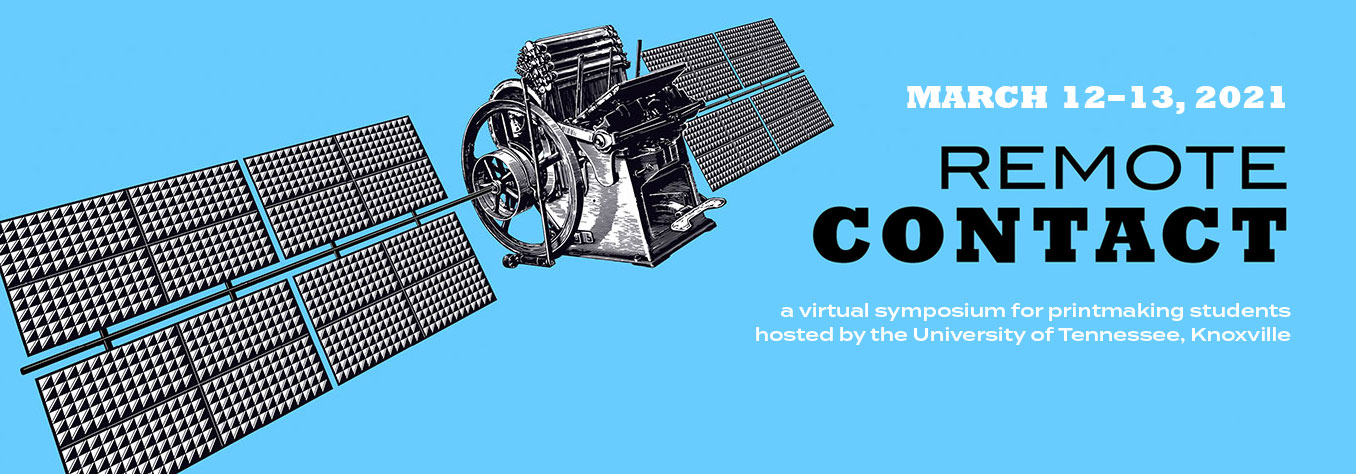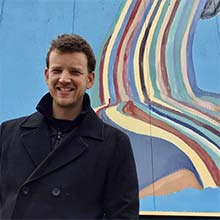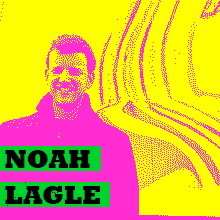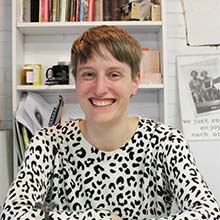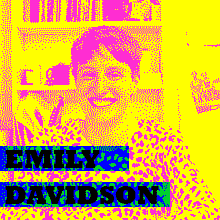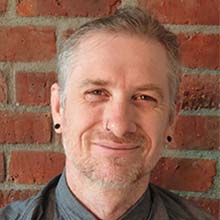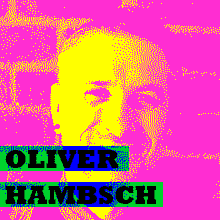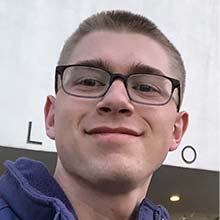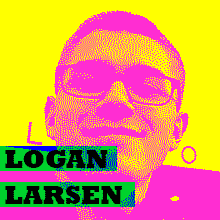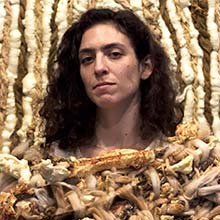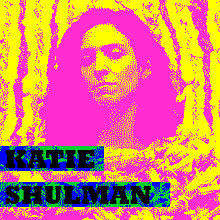
Sending Signals _friday, march 12_12:30–14:00 (eastern us)_
Prints as objects and printmaking as a discipline reside within syntactic systems of multiplicity, seriality, and the use of the matrix that often mirrors the ways in which we navigate linguistic systems of expression. This session brings together voices that explore visual, textual, and philosophical investigations of language in print media. Within the context of our socially distanced lives, we count on the power of the communicative signals we send to bring us closer together. How can we use translative processes to help us to transcend the borders that separate both people and art practices along lines of geography, community, culture, and medium? To help answer these questions, panelists will be discussing their individual relationships with print media and the particular ways in which print can be harnessed to (either alternatively or concurrently) hold, maintain, shape, alter, and disseminate information.
Noah Lagle _Panel Chair_
MFA student, University of Tennessee, Knoxville
Noah Lagle has had three hometowns, with his lifetime split evenly between San Diego, CA; West Chester, PA; and Burlington, VT before moving to Knoxville, TN to pursue his MFA in Printmaking. After studying Art, Anthropology, and Spanish at the University of Vermont, he continued to work there as a studio technician in printmaking and sculpture. Through founding Public Works Press, Lagle has printed and published the work of contemporary artists while facilitating public printmaking workshops. He is also a musician, an outdoor educator, and an avid board game player. noahlagle.com
Emily Davidson MFA student, Nova Scotia College of Art and Design University
"Letterpress Relations: First Steps in Rethinking the Dawson Printshop as Treaty Space." My research investigates the entangled relationship letterpress printing has as a tool of historic and ongoing colonization across North America, and the formation of settler-colonial states on Indigenous lands. The main questions framing this research are: What happens when the direct correlation of letterpress to colonialism is articulated, exposed, worked through and worked against? Can a colonial tool such as the letterpress be decolonized to participate in the resurgence of Indigenous land, cultural and language practices?
My project, Letterpress Relations: The Dawson Printshop as Treaty Space, focuses on archival research of letterpress printed documents that represent specific settler-colonial strategies in Canada between 1750 and 1950. These archival documents, such as broadsides, notices, treaty proclamations and newspapers, form a body of textual references that I respond to using the movable type from NSCAD University’s Dawson Printshop collection.
My research also involves exploring my own relationship to colonization and to decolonial strategies as a white queer woman settler and printmaker. I offer that the entanglement of objects, such as letterpress printed documents, in the ongoing and historical processes of colonization can provide an opportunity to use those objects as entry points into a process and action of decolonization. I explore ways to unsettle the dominant trend of recapitulating historic colonial aesthetics within contemporary letterpress print culture.
Emily Davidson is a settler artist, activist and graphic designer based in Kjipuktuk (Halifax, Nova Scotia, Canada). Her artistic practice uses printmaking to investigate the history of leftist political movements, imagine utopian futures, and agitate for social justice causes. Her current research focuses on the entangled relationship of print media in historic and ongoing colonization across Turtle Island, and the formation of settler-colonial states on Indigenous lands. Emily graduated from NSCAD University in 2009 (BFA, Interdisciplinary) and is a current MFA candidate at NSCAD. Emily is a recipient of the Canada Graduate Scholarships-Master’s Program in Social Sciences and Humanities Research Council of Canada (SSHRC). emilydavidsonart.com
Oliver Hambsch MFA student, Michaelis School of Fine Art, RSA, University of Cape Town
"Memory and the Visual Language of Print." The code and the encoding processes of print can be thought of as a form of language. Like spoken and written language, the visual language of print has its own formalized syntax (e.g. halftone and optical color mixing) and structure that are intended to communicate ideas and concepts. Print is similar to a programming language in that both consist of binary information (Field, 1994; Reeves, 1999) that, when formalized into a system, gives the illusion of analog or continuous information. By playing around with this syntax and its system, and consciously incorporating them into the concept, the artist can add additional layers of meaning to the print that extend beyond the image itself.
Using examples from my 2019 graduate work, I will demonstrate how the visual language of print can be used to communicate aspects of memory (in this case collective familial memory) that would be difficult to represent using another language system. Specifically, my work has aimed to visualize the gradual narrative decay of memory, and the process of trying to retrieve what has already been forgotten. The examples I will show include: a look at how sequential photocopying was used to simulate the process of forgetting; the use of toner powder as a symbolic substance; successive remediation to simulate the transmission of trans-generational memory, and the introduction of time into the print.
Oliver Hambsch is a South African-born German artist who works mainly in print media. Having studied graphic design and worked in the commercial art sector for a large part of his career, He has developed a deep fascination with print and the physicality of printed objects in an era where the digital, ephemeral image has become abundant. His particular interest lies in the family photographic archive as a reservoir of collective memory, and how the visual language of print can be used as a tool for investigation and representation. Hambsch received his Postgraduate Diploma in Fine Arts from the University of Cape Town in 2020, and his Cape Technikon; National Diploma in Graphic Design in 2003. He is currently a MFA candidate at the University of Cape Town Michaelis School of Fine Art. oliverhambsch.com
Logan Larsen recent BFA (Studio Art) and BA (Art History), University of Texas at Austin
"Reading In/Through/Around the Margins." My presentation centers on a grouping of works I’ve created which focus on the use of marginalia within secondhand books. These notations, in my view, create new and alternative narrative threads which shift and change the reading of a text. In my early work, I used J.D. Salinger’s The Catcher in the Rye as a starting point for this exploration, because of its wide circulation and national resonance. The annotations I culled from secondhand copies of the text alternated between extremely personal statements and highly banal musings focusing on the linguistic structure of the text itself. Through these left-over notations, I wondered if the text could be read through only these marks and I created a series of works to resolve this question. I produced two editions of The Catcher in the Rye without Salinger’s text, leaving only the anonymous annotations of their prior readers. The resulting books reflect the nature of reading, and the consumption of the text.
Recently, I have been more interested in creating the annotations I utilize. Works like my reproduction of James Baldwin’s Giovanni’s Room become more about my personal relationship to the text and act as a dialogue between Baldwin and myself. Through subsequent variations of the work and text, I continue this dialogue with myself, editing and reconsidering a number of the statements I made within the book as my understanding of self and my relation to love has changed.
Logan Larsen (b. 1998, Houston, TX) is a recent graduate from the University of Texas at Austin with degrees in both Studio Art and Art History. As an artist, his work touches and fuses a multitude of media including drawing, painting, publishing, and printmaking. He aims to interchange these mediums as necessary, allowing their hand-off to be a generative event and push against the separation(s) between these media. His work has been exhibited at the International Print Center New York, the Visual Arts Center at the University of Texas at Austin, and the National Young Arts Foundation. Larsen has worked as a Risograph Lab Fellow and manager at the University of Texas at Austin. He is currently based in Austin, TX. LoganLarsen.com
Katie Shulman recent MFA graduate, Syracuse University
"Body Language: Accessing the Extensive Vocabulary of Human Form Through Printmaking." An image is built through an accumulation of marks and can take many forms. Each mark leaves an impression—visual evidence of a body in motion. Due to printmaking’s reliance on transference to build imagery, I suggest that the medium has the unique ability to capture and preserve an artist’s physical effort. I believe that every single print can be read as documentation of motion or series of movements. Similar to dance notation—the written translation of dimensional movement—a print, built of individual marks, is its own notation system that describes and articulates the language of a moving body. To explore this theme, work by the following artists will be discussed: Richard Long, Yves Klein, Janine Antoni, Raoul-Auger Feuillet, David Hammond, Golnar Adili, Xu Bing, Julie Mehretu, and Maya Stern.
Katie Shulman is a fiber artist artist from Washington, DC who currently resides in Detroit, Michigan. She holds an MFA in Studio Art from Syracuse University and a BFA in Fine Art from The University of Michigan in Ann Arbor. Her abstract sculptures and installations have been shown at the Everson Museum in Syracuse and The Strohl Art Gallery in Chautauqua, New York. In addition to her art practice, Katie has an over eight-year career as an arts administrator. She has worked in various institutions of higher learning and nonprofit art spaces in New York City, including The 92nd Y, The Studio Institute, and Hunter College. katieshulman.com
